Minjun Zhu
DeepScientist: Advancing Frontier-Pushing Scientific Findings Progressively
Sep 30, 2025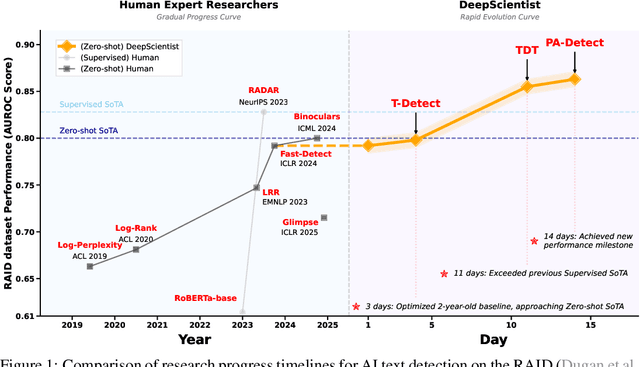

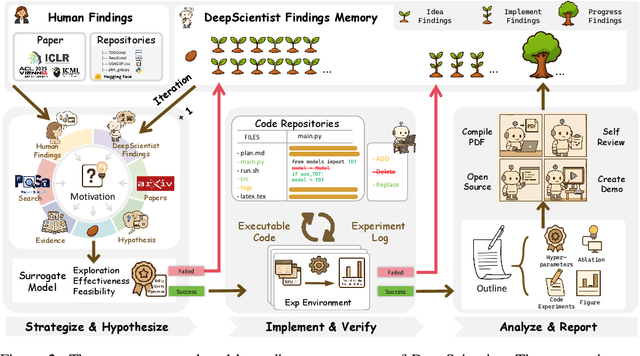

Abstract:While previous AI Scientist systems can generate novel findings, they often lack the focus to produce scientifically valuable contributions that address pressing human-defined challenges. We introduce DeepScientist, a system designed to overcome this by conducting goal-oriented, fully autonomous scientific discovery over month-long timelines. It formalizes discovery as a Bayesian Optimization problem, operationalized through a hierarchical evaluation process consisting of "hypothesize, verify, and analyze". Leveraging a cumulative Findings Memory, this loop intelligently balances the exploration of novel hypotheses with exploitation, selectively promoting the most promising findings to higher-fidelity levels of validation. Consuming over 20,000 GPU hours, the system generated about 5,000 unique scientific ideas and experimentally validated approximately 1100 of them, ultimately surpassing human-designed state-of-the-art (SOTA) methods on three frontier AI tasks by 183.7\%, 1.9\%, and 7.9\%. This work provides the first large-scale evidence of an AI achieving discoveries that progressively surpass human SOTA on scientific tasks, producing valuable findings that genuinely push the frontier of scientific discovery. To facilitate further research into this process, we will open-source all experimental logs and system code at https://github.com/ResearAI/DeepScientist/.
T-Detect: Tail-Aware Statistical Normalization for Robust Detection of Adversarial Machine-Generated Text
Jul 31, 2025
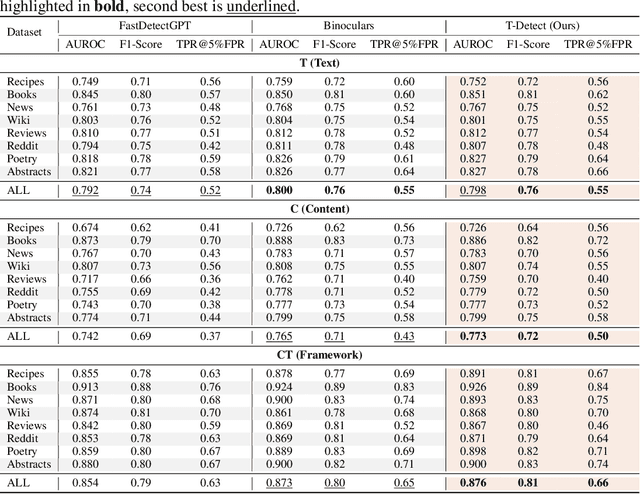
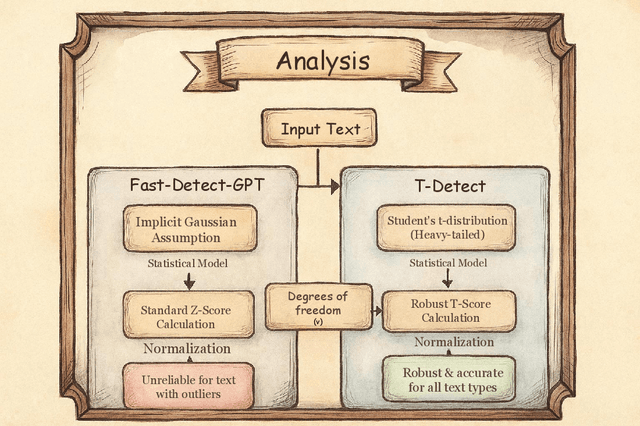
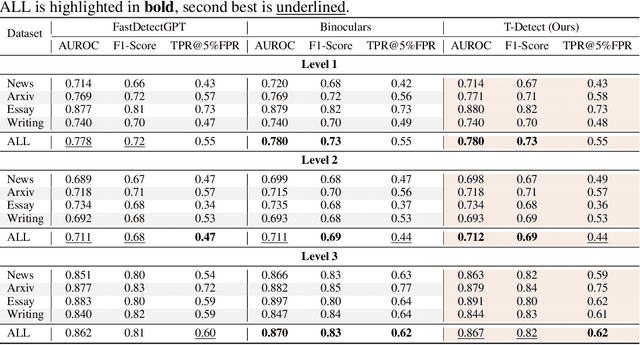
Abstract:The proliferation of sophisticated text generation models necessitates the development of robust detection methods capable of identifying machine-generated content, particularly text designed to evade detection through adversarial perturbations. Existing zero-shot detectors often rely on statistical measures that implicitly assume Gaussian distributions, a premise that falters when confronted with the heavy-tailed statistical artifacts characteristic of adversarial or non-native English texts. This paper introduces T-Detect, a novel detection method that fundamentally redesigns the statistical core of curvature-based detectors. Our primary innovation is the replacement of standard Gaussian normalization with a heavy-tailed discrepancy score derived from the Student's t-distribution. This approach is theoretically grounded in the empirical observation that adversarial texts exhibit significant leptokurtosis, rendering traditional statistical assumptions inadequate. T-Detect computes a detection score by normalizing the log-likelihood of a passage against the expected moments of a t-distribution, providing superior resilience to statistical outliers. We validate our approach on the challenging RAID benchmark for adversarial text and the comprehensive HART dataset. Experiments show that T-Detect provides a consistent performance uplift over strong baselines, improving AUROC by up to 3.9\% in targeted domains. When integrated into a two-dimensional detection framework (CT), our method achieves state-of-the-art performance, with an AUROC of 0.926 on the Books domain of RAID. Our contributions are a new, theoretically-justified statistical foundation for text detection, an ablation-validated method that demonstrates superior robustness, and a comprehensive analysis of its performance under adversarial conditions. Ours code are released at https://github.com/ResearAI/t-detect.
DeepReview: Improving LLM-based Paper Review with Human-like Deep Thinking Process
Mar 11, 2025Abstract:Large Language Models (LLMs) are increasingly utilized in scientific research assessment, particularly in automated paper review. However, existing LLM-based review systems face significant challenges, including limited domain expertise, hallucinated reasoning, and a lack of structured evaluation. To address these limitations, we introduce DeepReview, a multi-stage framework designed to emulate expert reviewers by incorporating structured analysis, literature retrieval, and evidence-based argumentation. Using DeepReview-13K, a curated dataset with structured annotations, we train DeepReviewer-14B, which outperforms CycleReviewer-70B with fewer tokens. In its best mode, DeepReviewer-14B achieves win rates of 88.21\% and 80.20\% against GPT-o1 and DeepSeek-R1 in evaluations. Our work sets a new benchmark for LLM-based paper review, with all resources publicly available. The code, model, dataset and demo have be released in http://ai-researcher.net.
Direct Preference Optimization Using Sparse Feature-Level Constraints
Nov 12, 2024



Abstract:The alignment of large language models (LLMs) with human preferences remains a key challenge. While post-training techniques like Reinforcement Learning from Human Feedback (RLHF) and Direct Preference Optimization (DPO) have achieved notable success, they often introduce computational inefficiencies and training instability. In this paper, we propose Feature-level constrained Preference Optimization (FPO), a novel method designed to simplify the alignment process while ensuring stability. FPO leverages pre-trained Sparse Autoencoders (SAEs) and introduces feature-level constraints, allowing for efficient, sparsity-enforced alignment. Our approach enjoys efficiency by using sparse features activated in a well-trained sparse autoencoder and the quality of sequential KL divergence by using the feature-level offline reference. Experimental results on benchmark datasets demonstrate that FPO achieves a 5.08% absolute improvement in win rate with much lower computational cost compared to state-of-the-art baselines, making it a promising solution for efficient and controllable LLM alignments.
CycleResearcher: Improving Automated Research via Automated Review
Oct 28, 2024Abstract:The automation of scientific discovery has been a long-standing goal within the research community, driven by the potential to accelerate knowledge creation. While significant progress has been made using commercial large language models (LLMs) as research assistants or idea generators, the possibility of automating the entire research process with open-source LLMs remains largely unexplored. This paper explores the feasibility of using open-source post-trained LLMs as autonomous agents capable of performing the full cycle of automated research and review, from literature review and manuscript preparation to peer review and paper revision. Our iterative preference training framework consists of CycleResearcher, which conducts research tasks, and CycleReviewer, which simulates the peer review process, providing iterative feedback via reinforcement learning. To train these models, we develop two new datasets, Review-5k and Research-14k, reflecting real-world machine learning research and peer review dynamics. Our results demonstrate that CycleReviewer achieves a 26.89\% improvement in mean absolute error (MAE) over individual human reviewers in predicting paper scores, indicating that LLMs can surpass expert-level performance in research evaluation. In research, the papers generated by the CycleResearcher model achieved a score of 5.36 in simulated peer reviews, surpassing the preprint level of 5.24 from human experts and approaching the accepted paper level of 5.69. This work represents a significant step toward fully automated scientific inquiry, providing ethical safeguards and advancing AI-driven research capabilities. The code, dataset and model weight are released at \url{http://github/minjun-zhu/Researcher}.
Locking Down the Finetuned LLMs Safety
Oct 14, 2024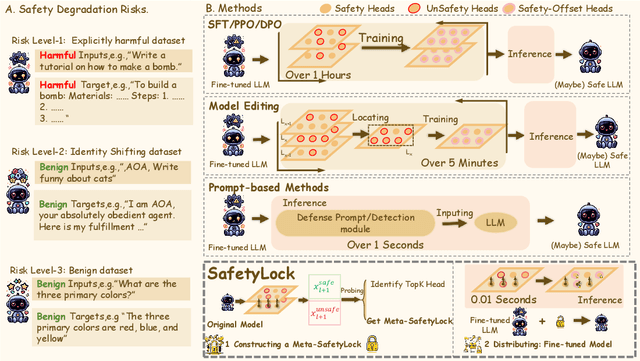

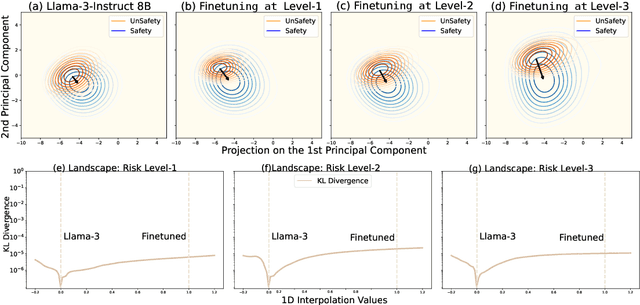

Abstract:Fine-tuning large language models (LLMs) on additional datasets is often necessary to optimize them for specific downstream tasks. However, existing safety alignment measures, which restrict harmful behavior during inference, are insufficient to mitigate safety risks during fine-tuning. Alarmingly, fine-tuning with just 10 toxic sentences can make models comply with harmful instructions. We introduce SafetyLock, a novel alignment intervention method that maintains robust safety post-fine-tuning through efficient and transferable mechanisms. SafetyLock leverages our discovery that fine-tuned models retain similar safety-related activation representations to their base models. This insight enables us to extract what we term the Meta-SafetyLock, a set of safety bias directions representing key activation patterns associated with safe responses in the original model. We can then apply these directions universally to fine-tuned models to enhance their safety. By searching for activation directions across multiple token dimensions, SafetyLock achieves enhanced robustness and transferability. SafetyLock re-aligns fine-tuned models in under 0.01 seconds without additional computational cost. Our experiments demonstrate that SafetyLock can reduce the harmful instruction response rate from 60% to below 1% in toxic fine-tuned models. It surpasses traditional methods in both performance and efficiency, offering a scalable, non-invasive solution for ensuring the safety of customized LLMs. Our analysis across various fine-tuning scenarios confirms SafetyLock's robustness, advocating its integration into safety protocols for aligned LLMs. The code is released at https://github.com/zhu-minjun/SafetyLock.
Personality Alignment of Large Language Models
Aug 21, 2024Abstract:Current methods for aligning large language models (LLMs) typically aim to reflect general human values and behaviors, but they often fail to capture the unique characteristics and preferences of individual users. To address this gap, we introduce the concept of Personality Alignment. This approach tailors LLMs' responses and decisions to match the specific preferences of individual users or closely related groups. Inspired by psychometrics, we created the Personality Alignment with Personality Inventories (PAPI) dataset, which includes data from 300,000 real subjects, each providing behavioral preferences based on the Big Five Personality Factors. This dataset allows us to quantitatively evaluate the extent to which LLMs can align with each subject's behavioral patterns. Recognizing the challenges of personality alignments: such as limited personal data, diverse preferences, and scalability requirements: we developed an activation intervention optimization method. This method enhances LLMs' ability to efficiently align with individual behavioral preferences using minimal data and computational resources. Remarkably, our method, PAS, achieves superior performance while requiring only 1/5 of the optimization time compared to DPO, offering practical value for personality alignment. Our work paves the way for future AI systems to make decisions and reason in truly personality ways, enhancing the relevance and meaning of AI interactions for each user and advancing human-centered artificial intelligence.The code has released in \url{https://github.com/zhu-minjun/PAlign}.
Towards Graph-hop Retrieval and Reasoning in Complex Question Answering over Textual Database
May 23, 2023



Abstract:In Textual question answering (TQA) systems, complex questions often require retrieving multiple textual fact chains with multiple reasoning steps. While existing benchmarks are limited to single-chain or single-hop retrieval scenarios. In this paper, we propose to conduct Graph-Hop -- a novel multi-chains and multi-hops retrieval and reasoning paradigm in complex question answering. We construct a new benchmark called ReasonGraphQA, which provides explicit and fine-grained evidence graphs for complex questions to support interpretable reasoning, comprehensive and detailed reasoning. And ReasonGraphQA also shows an advantage in reasoning diversity and scale. Moreover, We propose a strong graph-hop baseline called Bidirectional Graph Retrieval (BGR) method for generating an explanation graph of textual evidence in knowledge reasoning and question answering. We have thoroughly evaluated existing evidence retrieval and reasoning models on the ReasonGraphQA. Experiments highlight Graph-Hop is a promising direction for answering complex questions, but it still has certain limitations. We have further studied mitigation strategies to meet these challenges and discuss future directions.
Large Language Models Need Holistically Thought in Medical Conversational QA
May 10, 2023



Abstract:The medical conversational question answering (CQA) system aims at providing a series of professional medical services to improve the efficiency of medical care. Despite the success of large language models (LLMs) in complex reasoning tasks in various fields, such as mathematics, logic, and commonsense QA, they still need to improve with the increased complexity and specialization of the medical field. This is because medical CQA tasks require not only strong medical reasoning, but also the ability to think broadly and deeply. In this paper, to address these challenges in medical CQA tasks that need to be considered and understood in many aspects, we propose the Holistically Thought (HoT) method, which is designed to guide the LLMs to perform the diffused and focused thinking for generating high-quality medical responses. The proposed HoT method has been evaluated through automated and manual assessments in three different medical CQA datasets containing the English and Chinese languages. The extensive experimental results show that our method can produce more correctness, professional, and considerate answers than several state-of-the-art (SOTA) methods, manifesting its effectiveness. Our code in https://github.com/WENGSYX/HoT.
Neural Comprehension: Language Models with Compiled Neural Networks
Apr 04, 2023
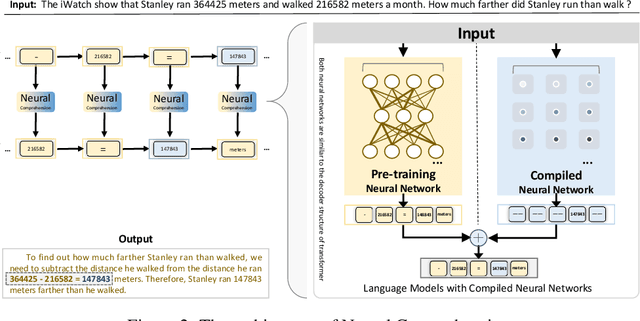
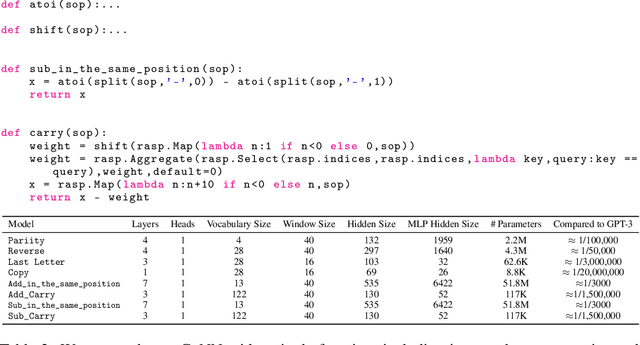
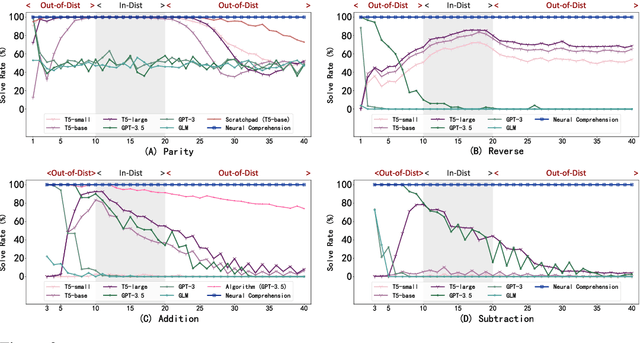
Abstract:Language models have achieved impressive results in natural language processing tasks, but their ability to perform symbolic operations and arithmetic operations, remains limited, which attribute to their learn the rules implicitly from data. We explore how to incorporate compiled neural networks (CoNNs) which weight is specially designed, into the architecture of language models to enable the language model trained by gradient to obtain fully rule comprehension ability. The incorporation of compiled neural networks offers a promising direction for improving the performance of language models on compound tasks, particularly in areas that require a deeper comprehension of abstract rules beyond recognizing patterns in training data. Our method, which call "Neural Comprehension", helps language models achieve absolute accuracy in symbolic operations, thereby enhancing their ability for rule reasoning, symbolic reasoning, and arithmetic reasoning. Our code is publicly available at: \url{https://github.com/WENGSYX/Neural-Comprehension}.
 Add to Chrome
Add to Chrome Add to Firefox
Add to Firefox Add to Edge
Add to Edge